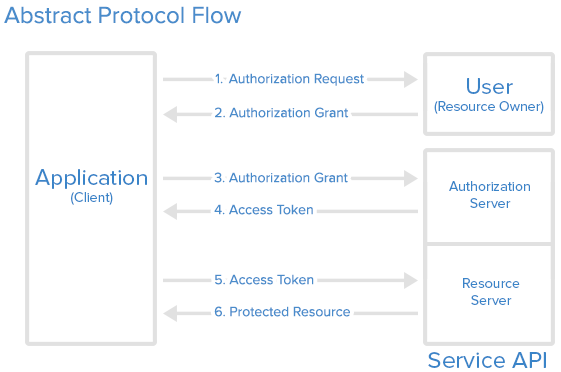WISE-PaaS/Single Sign-On(SSO)
Single Sign-On (SSO) is part of Advantech WISE-PaaS cloud solution and plays an important role in the interoperability of Internet identity. It provides a central login mechanism.
OpenID Connect utilizes Keycloak which is an open source identity and access management for modern applications and services.
Contents
- 1 API Protocol Flow
- 2 Features Overview
- 3 Components
- 4 Implementation
- 4.1 Settings on Authorization Server
- 4.2 Application for end user
- 4.3 Verify Access Token on Resource Server
- 5 Document
API Protocol Flow
WISE-PaaS/Single Sign-On use the OAuth 2.0 protocol for authentication and authorization.
- User/Resource owner : Who authorizes others to access Protected Resource. If the role is human, it means the end-user.
- Application/Client/Browse : An application ,client or a browser page represents the Resource Owner to access the Protected Resource.
- Authorize Server : The server issues the Access Token after user are authenticated. (WISE-PaaS/Single Sign-On server)
- Resource Server : The server hosting Protected Resource accept requests according to Access Token.
Here is a more detailed explanation of the steps in the diagram:
- The application requests authorization to access service resources from the user
- If the user authorized the request, the application receives an authorization grant
- The application requests an access token from the authorization server (API) by presenting authentication of its own identity, and the authorization grant
- If the application identity is authenticated and the authorization grant is valid, the authorization server (API) issues an access token to the application. Authorization is complete.
- The application requests the resource from the resource server (API) and presents the access token for authentication
- If the access token is valid, the resource server (API) serves the resource to the application
Features Overview
WISE-PaaS/Single Sign-On(SSO) which base on keycloak has the following features.
- Single-Sign On : Login once to multiple applications
- Standard Protocols : OpenID Connect, OAuth 2.0 and SAML 2.0
- Centralized Management : For admins and users
- Adapters : Secure applications and services easily
- High Performance : Lightweight, fast and scalable
- Clustering : For scalability and availability
- Themes : Customize look and feel
- Extensible : Customize through code
- Password Policies : Customize password policies
Components
[Please describe]
- OpenID Connect Server
- OpenID Connect Client
- OAuth 2.0 Server
- OAuth 2.0 Client
Implementation
WISE-PaaS provides a complete service for Single Sign-On. There are tree sections for developer to implement.
Settings on Authorization Server
Apply a manager account for OpenID Central Server.Please send a request to WISE-Paas/OpenID Connect service manager by E-mail. And provide the following information
Setting your service on Single Sign-On server
Login Single Sign-On server
Authorization Setting
Get Client App setting
Application for end user
- Copy the json , html sample code to your local web site.
- Modify json setting
- Once the test HTML page is opened, it is automatically directed to OpenID Connect Server.
- While login success, it will automatically lead back to test page.
Verify Access Token on Resource Server
Add the jwt decode for your access token. Here is a Java client sample code.
- Maven Dependency
<code data-lang="xml"><dependencies>
<dependency>
<groupId>org.keycloak</groupId>
<artifactId>keycloak-authz-client</artifactId>
<version>${KEYCLOAK_VERSION}</version>
</dependency>
</dependencies></code>
- Obtaining User Entitlements
<code data-lang="java">// create a new instance based on the configuration defined in keycloak-authz.json
AuthzClient authzClient = AuthzClient.create();
// obtain an Entitlement API Token to get access to the Entitlement API.
// this token is an access token issued to a client on behalf of an user
// with a scope = kc_entitlement
String eat = getEntitlementAPIToken(authzClient);
// send the entitlement request to the server to
// obtain an RPT with all permissions granted to the user
EntitlementResponse response = authzClient.entitlement(eat)
.getAll("hello-world-authz-service");
String rpt = response.getRpt();
System.out.println("You got a RPT: " + rpt);
// now you can use the RPT to access protected resources on the resource server</code>

